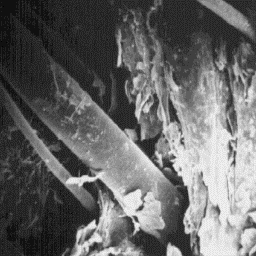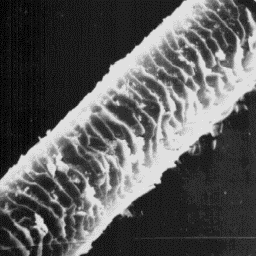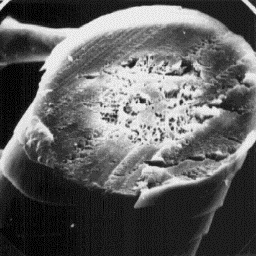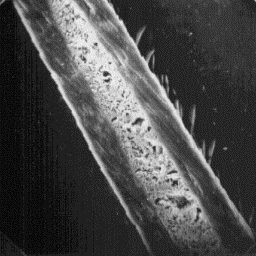 Taurotragus oryx
Taurotragus oryx
----------------
English: Eland
German: Elenantilope
French: Antilope canna
Spanish: Antilope canna
Distribution areas
------------------
The eland lives in South and Central
Africa. It has become rare in its natural
habitat and is often raised in zoos.
Description of the fur
----------------------
The skins are up to 330 cm long. The fur The surface structure
coat is relatively coarse and measures up of the skin, 200x
to 20 mm in thickness. The colour of the
hair is light-brown on the back, while the sides and the belly are
yellow-grey in colour. Along the backbone is a darker red-brown strip. The
hair shafts are straight and the underfur layer is not distinguishable.
|
|
 Taurotragus oryx
Taurotragus oryx
----------------
English: Eland
German: Elenantilope
French: Antilope canna
Spanish: Antilope canna
Structure of the hair
---------------------
The microscopic skin surface structure
appears furrowed. The hair follicles are
narrow with straight edges. The average
follicle is single-haired.
The fine fur are circular, and in the
upper part of the hair shaft elliptical, in The cuticular structure
cross-section. The diameter is in the range of the fine fibres, 600x
of 20 to 35 µm. The cuticular scales are
cornet-like with a smooth surface and crenated scale margins. These fibres
have a narrow, unbroken, central symmetrical-shaped medulla, which is of the
sponge-cortex-like type with a foam-like or an amorphous infilling substance.
|
|
 Taurotragus oryx
Taurotragus oryx
----------------
English: Eland
German: Elenantilope
French: Antilope canna
Spanish: Antilope canna
Intermediate fibres have a circular, and
in the upper part of the shaft elliptical,
cross-section with a diameter of 50 to 70
µm. The cuticle is even, tile-like at the
lowest part, and crenated, tile-like in the
middle and upper parts, of the shaft. The
scale surface is smooth and scale margins
straight and rippled. The medulla is wide,
unbroken and central symmetrical-shaped in The cuticular structure
cross-section. The overall structure of the of the fine fibres, 600x
medulla is of the sponge-cortex-like type.
The infilling medullar substance is foam-like or an amorphous in detailed
structure.
The guard hairs are elliptical in cross-sectional outline with a diameter
from 70 to 85 µm. The scales of the cuticles are even, tile-like at the base
and crenated, tile-like in the most of the shaft.
|
|
 Taurotragus oryx
Taurotragus oryx
----------------
English: Eland
German: Elenantilope
French: Antilope canna
Spanish: Antilope canna
The scale surface is smooth and scale
margins rippled, with the exception of the
lowest part, when the margins are straight.
The medulla is wide, unbroken and central
symmetrical-shaped in cross-section. The
overall medullary pattern is of the sponge
-cortex-like structure and the infilling
substance is foam-like and amorphous.
Transverse section
of an intermediate fibre, 2000x
|
|
 Taurotragus oryx
Taurotragus oryx
----------------
English: Eland
German: Elenantilope
French: Antilope canna
Spanish: Antilope canna
Longitudinal section
of a guard hair, 600x
Numerical code for eland skin structure
---------------------------------------
Surface of the skin: 3-4-1
Fine fur fibres: 1.2-5-1-2-2-1-1-7-5.8-20.35-6.12
Intermediate fibres: 2.1-2.4-1-1.2-2-1-1-7-5.8-50.71-10.16
Guard hairs: 2-4.2-1-2.1-2-1-1-7-5.8-70.55-10.22
|




